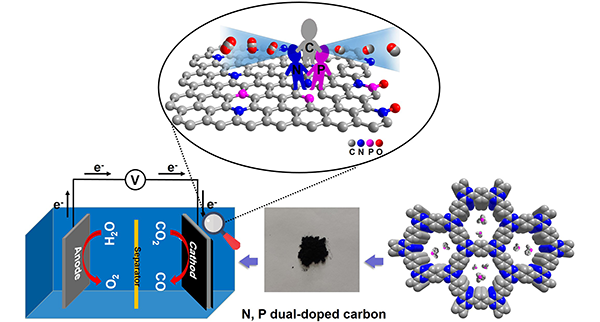Covalent Triazine Frameworks-derived N,P Dual-doped Porous Carbons for Highly Efficient Electrochemical Reduction of CO2
ZHANG Meng-Di, YI Jun-Dong, HUANG Yuan-Biao* and CAO Rong*
Chin. J. Struct. Chem. 2021, 40, 1213-1222 DOI: 10.14102/j.cnki.0254-5861.2011-3118
September 15, 2021
carbon dioxide, electrocatalysis, covalent triazine frameworks, N,P dual-doped carbons, carbon monoxide
ABSTRACT
Electroreduction of CO2 into chemicals is of great importance in the global carbon balance. Although
noble-metal based catalysts and single-atom catalysts (SACs) are known to be
active for CO2 electrore- duction reaction (CO2RR), the
high cost of noble-metal and the lack of effective synthesis approaches to
prepare SACs have tremendously hindered the application. Non-metal doped carbon
materials have attracted great interest because of their reasonable cost,
chemical stability and excellent electrical conductivity. Nevertheless, the
design and fabrication of highly efficient non-metal doped carbon electrocatalysts
for CO2RR to meet industry demands still remains a big challenge.
Herein, triphenylphosphine@covalent triazine frameworks (CTFs)
composite
s
were employed as precursors to
fabricate N,P dual-doped porous carbon catalysts PCTF-X-Y (X represents the
carbonization temperature, and Y represents the mass ratio of CTF to
triphenylphosphine) for CO2RR. Due to the high specific surface
areas and synergistic effect between N and P, the obtained PCTF-1000-5
exhibited high selectivity for CO production up to 84.3% at –0.7 V versus the reversible hydrogen electrode (vs.
RHE) and long-term durability over 16 h, which are better than the reported N,P
dual-doped carbon catalysts in aqueous media. This work provides a new way to
design and fabricate non-metal catalysts for electrocatalysis.








